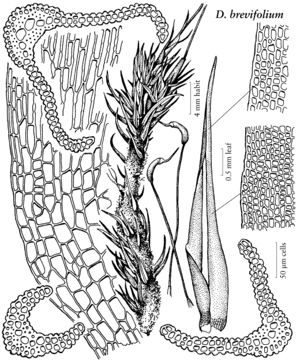Dicranum brevifolium
Musc. Scand., 24. 1879,.
Plants in dense tufts, light to dark green, dark brown or sometimes nearly black, dull. Stems 2–8 cm, densely tomentose with brown to orange rhizoids nearly to stem apex. Leaves falcate-secund to erect-spreading, often at wide angles from stems, strongly crisped when dry, often with a few undulations in the distal half, (3–)5.5–6.5(–8.5) × 0.4–0.8 mm, concave below, keeled above, lanceolate, acute; margins entire below, serrulate above, incurved in the middle of the leaf; laminae 1-stratose or with 2-stratose regions in distal half of leaf, especially on margins, sometimes with entire laminae 2-stratose, rarely margins 3-stratose; costa percurrent or shortly excurrent, 1/6–1/4 the width of the leaves at base, very prominent and rounded on abaxial surface, smooth or slightly rough above on abaxial surface, abaxial ridges absent, shaped like a pair of tongs, with one row of guide cells, 2 well-developed and thick stereid bands extending to the apex, adaxial epidermal layer of cells not differentiated, the abaxial layer differentiated; cell walls between lamina cells strongly bulging; leaf cells smooth to papillose above on abaxial surface; alar cells 2-stratose, differentiated, sometimes extending to costa; proximal laminal cells elongate-rectangular, pitted or not pitted, (15–)31–46(–75) × (5–)7–9(–12) µm; distal laminal cells short, irregularly quadrate-rectangular, not pitted, (5–)7–14(–37) × (4–)8–9(–13) µm. Sexual condition pseudomonoicous; dwarf males on stem rhizoids of female plants; interior perichaetial leaves abruptly short-acuminate, convolute-sheathing. Seta 1.3–3.5 cm, solitary, yellowish to brown. Capsule 2–4 mm, long-cylindric, arcuate, inclined to horizontal, not or slightly strumose, striate to furrowed when dry, yellowish brown to dark brown; operculum 1–2.5 mm. Spores 14–30 µm.
Phenology: Capsules mature summer.
Habitat: Humus or soil over rock, rarely rotted wood, exposed to protected bluffs or cliffs, 70-3700 m
Distribution

Greenland, Alta., B.C., Man., Nfld. and Labr. (Nfld.), N.W.T., Nunavut, Ont., Que., Yukon, Alaska, Colo., Mich., Mont., N.Mex., S.Dak., Europe, Asia.
Discussion
The distinctive leaves of Dicranum brevifolium are 4–8 mm, acute, often weakly undulate in the distal part, crisped when dry, standing out from the stems often at wide angles, concave proximally, and keeled distally, the laminae are often 2-stratose above, especially on margins and near costa, sometimes entirely 2-stratose with 3-stratose margins (sometimes apparent on plants at relatively high altitudes in the mountains in Alberta), and the costa is excurrent, very prominent and conspicuously rounded, especially noticeable below the leaf middle. The leaves in cross section are very distinctive, being shaped like a pair of tongs; abaxial epidermal layer of costal cells is differentiated but no adaxial epidermal layer cells are enlarged, and the cell walls between the lamina cells are almost always strongly bulging. Dicranum brevifolium has commonly been confused with three other species, D. muehlenbeckii, D. acutifolium, and D. fuscescens. Dicranum muehlenbeckii has only 1-stratose leaf laminae and the costae are much less prominent on the abaxial leaf surface than those of D. brevifolium. A cross section of the distal half of the leaves of D. muehlenbeckii shows a tubular outline with the cell walls between the lamina cells smooth and adaxial epidermal layer of costal cells differentiated, while the leaves of D. brevifolium are tong-shaped in outline with the cell walls between lamina cells strongly bulging and the adaxial epidermal layer of costal cells undifferentiated. Dicranum acutifolium differs from D. brevifolium by its erect-spreading to slightly curled leaves when dry, instead of crisped leaves standing out from the stems at wide angles, its costae that are usually moderately distinct and sometimes nearly flat on the abaxial surface, instead of being prominent and conspicuously rounded, its V-shaped leaves in cross section, instead of tong-shaped leaves, and its shorter capsules, 2–2.7 mm, compared to 2–4 mm. Dicranum fuscescens differs from D. brevifolium by its much less prominent costae on the abaxial leaf surface, by its V-shaped leaves in cross section, instead of tong-shaped leaves, and by its weakly bulging cell walls as seen in cross section.
The 2- or occasionally 3-stratose leaf laminae are unusual in the genus Dicranum. The only other species in North America with laminae often completely 2-stratose in the distal half is D. fulvum. No 3-stratose leaf laminae have been seen in that species, however. A recently described species in section Dicranum (where D. scoparium belongs) D. crassifolium C. Sérgio, R. Ochyra & A. Séneca, from Portugal, Spain, and Italy, has 2–3-stratose leaves. It is very unusual for a species in the type section to have anything but 1-stratose leaves.
Selected References
None.
